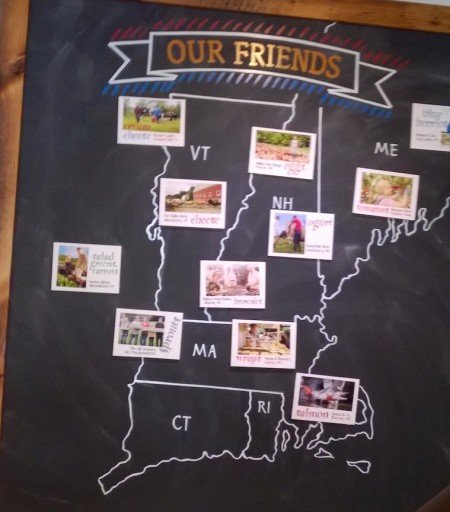
Some suppliers of The Works in Brattleboro Vermont
It is not often that I come across a restaurant that appears to place as much pride in their environmental consciousness as they do in their food and menu planning. The Works in Brattleboro, Vermont is one such place. I was not even actively looking to have lunch at a “sustainable” restaurant—I just wanted lunch. The food looked good and was a good value for what I was paying. Also, I had never thought of using goat cheese and kale in macaroni and cheese. It was really, really good!
As I was eating, I looked around and I saw a map of New England with squares on it. The map was actually a guide to where they got some of their food ingredients from. Each square was accompanied by a little blurb that told you a little bit about the supplying farm, or company. I liked the relative transparency, and their willingness to give me a better sense of where my food was coming from. Admittedly, these blurbs did not cover the entire supply chain and range of ingredients, but it was a very good start. A key part of sustainability for me is the ability to understand more about where the products I buy come from.
An extra sustainability bonus to the lunch experience was seeing a sign outlining some of the sustainability aspects of renovating the place. Some of these included reusing variety of flooring, buying local furniture when possible, reusing parts of farm equipment and an old school chalkboard etc. The sign may have been a good piece of marketing, but beyond creating a feel-good for the reader it also advertises an earth-friendly philosophy.
This particular lunch was emblematic of the type of experience I would want from any business claiming good sustainability practices. First and foremost, I am getting good value for the sales price—in this, very tasty food prepared in a reasonable amount of time. Now that I am a satisfied customer, I am very willing and even eager to appreciate the sustainability aspects of the business in question. In this case, these aspects made the lunch experience there even more memorable.
 My favorite Philadelphia DJ is Pierre Robert, whose show is mid-days on 93.3 WMMR. WMMR is about 50 years old, and has specialized in rock music the entire time. Pierre’s show regularly features music from the 1960s to the current day, with everything in between, including a “vinyl cut” each day. I knew that he knows absolutely everybody in the rock music business. I learned during a recent Eagles bloc that he is very interested in the environment in addition to rock music.
My favorite Philadelphia DJ is Pierre Robert, whose show is mid-days on 93.3 WMMR. WMMR is about 50 years old, and has specialized in rock music the entire time. Pierre’s show regularly features music from the 1960s to the current day, with everything in between, including a “vinyl cut” each day. I knew that he knows absolutely everybody in the rock music business. I learned during a recent Eagles bloc that he is very interested in the environment in addition to rock music.
 The true answer is that sustainability often makes sense economically. Many companies saved money over the long run (witness lower operating costs for LEED certified buildings). An ever increasing number of consumers and purchasers demanded it (exemplified by adding sustainability clauses to purchasing contracts). Perhaps most tellingly, when a company launched or increased a sustainability initiative, it used to be news—in some cases, big news. Now, measuring sustainability impact and improvements are becoming almost as widespread as….measuring profit.
The true answer is that sustainability often makes sense economically. Many companies saved money over the long run (witness lower operating costs for LEED certified buildings). An ever increasing number of consumers and purchasers demanded it (exemplified by adding sustainability clauses to purchasing contracts). Perhaps most tellingly, when a company launched or increased a sustainability initiative, it used to be news—in some cases, big news. Now, measuring sustainability impact and improvements are becoming almost as widespread as….measuring profit. The kerfuffle over the recent confirmation of Scott Pruitt to be the Director of the EPA has brought the issue of climate change to the fore. The general debate has been about how much governmental regulations should (or, should not) address various climate change types of issues. Count me amongst those that feel strongly that government(s) need(s) to take an active role on this. However, that does not mean that there is no room for the private sector. In fact, one can make an argument that strong involvement by the private sector will be equally as long lasting if not more so than governmental policy—due to the profit incentive. Profits have a way of outlasting elections results.
The kerfuffle over the recent confirmation of Scott Pruitt to be the Director of the EPA has brought the issue of climate change to the fore. The general debate has been about how much governmental regulations should (or, should not) address various climate change types of issues. Count me amongst those that feel strongly that government(s) need(s) to take an active role on this. However, that does not mean that there is no room for the private sector. In fact, one can make an argument that strong involvement by the private sector will be equally as long lasting if not more so than governmental policy—due to the profit incentive. Profits have a way of outlasting elections results. Sustainability can pop up in the most surprising places. The latest example I have found of this is a chapter in a textbook that my wife is using to teach English as a Second Language (ESL) this semester. I knew that more and more universities had been offering courses on different aspects of sustainability; but I had no idea that other unrelated courses would include it in their textbooks as well.
Sustainability can pop up in the most surprising places. The latest example I have found of this is a chapter in a textbook that my wife is using to teach English as a Second Language (ESL) this semester. I knew that more and more universities had been offering courses on different aspects of sustainability; but I had no idea that other unrelated courses would include it in their textbooks as well.
 Nashville, Tennessee, brands itself as Music City, USA. To a large extent, that is true, but it is not the entire story. I recently spent several days in Nashville at a conference, and I was very pleasantly surprised to see many instances of sustainability in practice. My first clue was the sign noting that the Music City Conference Center (where my conference was held) is a LEED Gold certified facility. That was interesting, and really something I had not anticipated. Nor did I anticipate learning of the center’s 4 acre green roof, part of which is inhabited by clusters of honey bees.
Nashville, Tennessee, brands itself as Music City, USA. To a large extent, that is true, but it is not the entire story. I recently spent several days in Nashville at a conference, and I was very pleasantly surprised to see many instances of sustainability in practice. My first clue was the sign noting that the Music City Conference Center (where my conference was held) is a LEED Gold certified facility. That was interesting, and really something I had not anticipated. Nor did I anticipate learning of the center’s 4 acre green roof, part of which is inhabited by clusters of honey bees. It is time to buy some new clothes, especially jeans. In addition to the usual issues I have finding a pair that actually fits, I am also dreading the idea of buying more cotton which is notorious for heavy environmental impact. Enter the Better Cotton Initiative, which is coalition of cotton producers, clothing designers and retailers sharing a common goal to make cotton production, “better”. By “better” they mean “better’ than currently. This goal primarily focuses on lessening the environmental impact of cotton production, but also focuses on increasing the economic viability of those who do.
It is time to buy some new clothes, especially jeans. In addition to the usual issues I have finding a pair that actually fits, I am also dreading the idea of buying more cotton which is notorious for heavy environmental impact. Enter the Better Cotton Initiative, which is coalition of cotton producers, clothing designers and retailers sharing a common goal to make cotton production, “better”. By “better” they mean “better’ than currently. This goal primarily focuses on lessening the environmental impact of cotton production, but also focuses on increasing the economic viability of those who do. For Broadway fans, the title of this post recalls the famous musical, A Chorus Line. However, a new One—Singular Sensation has arisen in New York City—the One World Trade Center building, The previous North and South Towers were designed in the late 1960s; the new One was designed in the 2000s and therefore incorporates the latest green building techniques, In fact, some of the (green) techniques used in the design of One World Trade have been incorporated into building codes in New York City and beyond
For Broadway fans, the title of this post recalls the famous musical, A Chorus Line. However, a new One—Singular Sensation has arisen in New York City—the One World Trade Center building, The previous North and South Towers were designed in the late 1960s; the new One was designed in the 2000s and therefore incorporates the latest green building techniques, In fact, some of the (green) techniques used in the design of One World Trade have been incorporated into building codes in New York City and beyond